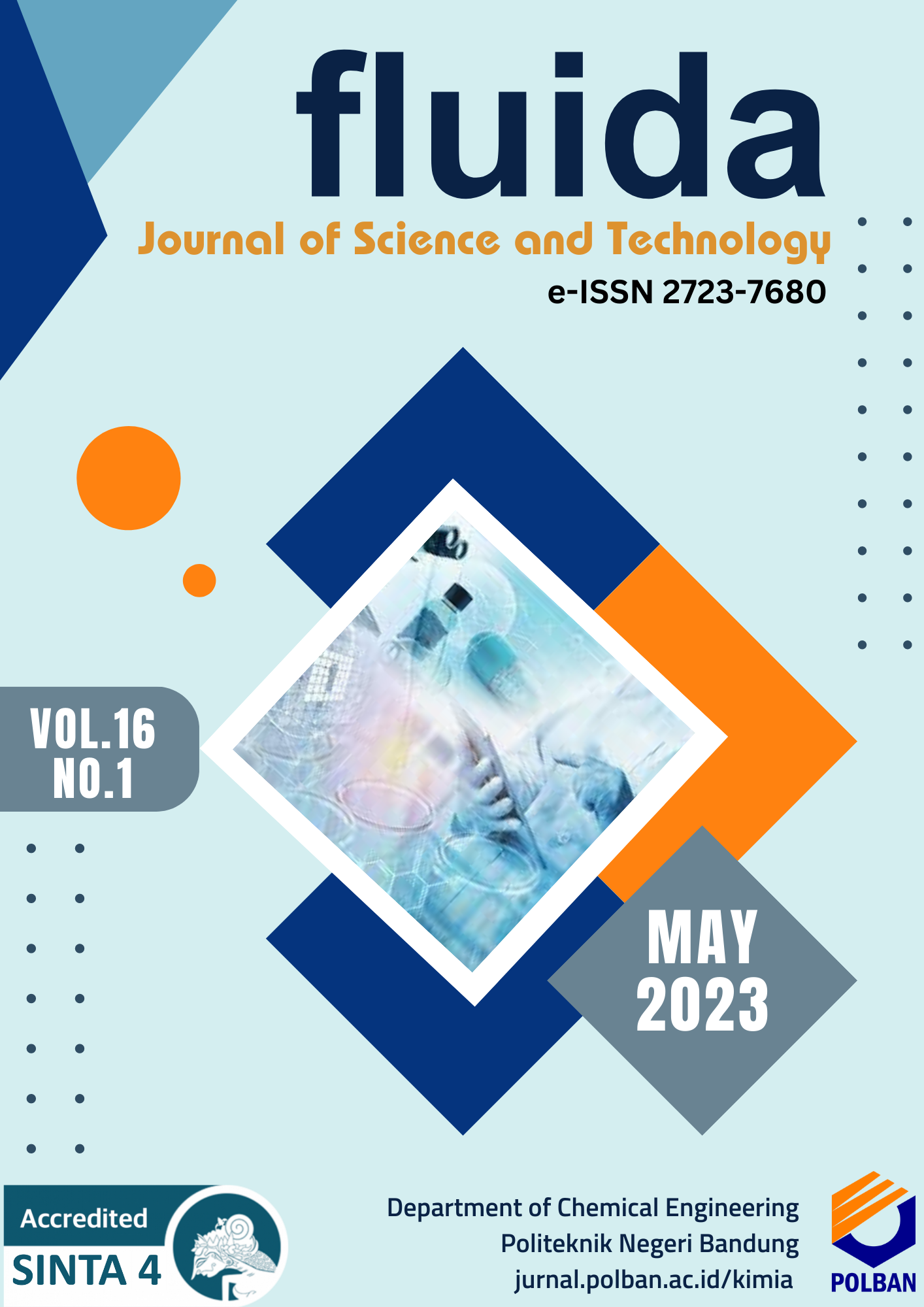Determination Of Optimum Drying Condition On Flavonoid Content Of Ficus Carica L. Leaves Using Tray Dryer
Main Article Content
Abstract
This research aims to find out the characteristics of Ficus carica L. drying process using a tray dryer and determine the effect of temperature and drying time on Ficus Carica L. flavonoid content using a tray dryer to obtain Ficus carica L. herbal leaf tea which is high in antioxidants. At the experimental stage, the water content of fresh leaves of Ficus carica L. were determined, so the water content is 74 ± 1.11% (wet base), then dried using a tray dryer at 35; 40; 45; 50; and 55oC, with a variation of the drying air flow rate of 1.3; 1.6; 1.9; 2.2; and 2.4 m/s. The optimum temperature and drying air flow rate are 50oC and 1.9 m/s since the highest flavonoid content was obtained at those condition as much 0.78 ± 0.001 gram QE/100gram extract. Dried products which packaged in tea bags have a content of 23.60% carbohydrate, total fat 3.50%, protein 5.35%,antioxidant 154.25 ppm and calorific value of 1430 Kcal/100 grams. It can be concluded that Ficus carica L. drying process using a tray dryer can be used to produce herbal leaf tea which is high in antioxidants and flavonoid content.
Downloads
Article Details
An author who publishes in the FLUIDA journal agrees to the following terms:
- Author retains the copyright and grants the journal the right of first publication of the work simultaneously licensed under the Creative Commons Attribution-ShareAlike 4.0 License that allows others to share the work with an acknowledgement of the work's authorship and initial publication in this journal
- Author is able to enter into separate, additional contractual arrangements for the non-exclusive distribution of the journal's published version of the work (e.g., post it to an institutional repository or publish it in a book) with the acknowledgement of its initial publication in this journal.
- Author is permitted and encouraged to post his/her work online (e.g., in institutional repositories or on their website) prior to and during the submission process, as it can lead to productive exchanges, as well as earlier and greater citation of the published work (See The Effect of Open Access).
Read more about the Creative Commons Attribution-ShareAlike 4.0 Licence here: https://creativecommons.org/licenses/by-sa/4.0/.
References
[2] O. Rebai and F. Sami, Fig (Ficus carica): Production, Processing, and Properties, no. February. 2023. doi: 10.1007/978-3-031-16493-4.
[3] R. Rodríguez Solana and A. Romano, “ Chemical and Biological Characteristics of Ficus carica L. Fruits, Leaves, and Derivatives (Wine, Spirit, and Liqueur) ,” Modern Fruit Industry, 2020, doi: 10.5772/intechopen.86660.
[4] S. Mawa, K. Husain, and I. Jantan, “Ficus carica L. (Moraceae): Phytochemistry, traditional uses and biological activities,” Evidence-based Complementary and Alternative Medicine, vol. 2013, 2013, doi: 10.1155/2013/974256.
[5] E. Agustina, “Uji Aktivitas Senyawa Antioksidan dari Ekstrak Daun Tin (Ficus Carica Linn) dengan Pelarut Air, Metanol, dan Campuran Metanol-Air,” KLOROFIL: Jurnal Ilmu Biologi dan Terapan, vol. 1, no. 1, p. 38, 2017, doi: 10.30821/kfl:jibt.v1i1.1240.
[6] K. E. Heim, A. R. Tagliaferro, and D. J. Bobilya, “Flavonoid antioxidants: Chemistry, metabolism and structure-activity relationships,” Journal of Nutritional Biochemistry, vol. 13, no. 10, pp. 572–584, 2002, doi: 10.1016/S0955-2863(02)00208-5.
[7] P. G. Pietta, “Flavonoids as antioxidants,” J Nat Prod, vol. 63, no. 7, pp. 1035–1042, 2000, doi: 10.1021/np9904509.
[8] M. Tzanova, V. Atanasov, Z. Yaneva, D. Ivanova, and T. Dinev, “Selectivity of current extraction techniques for flavonoids from plant materials,” Processes, vol. 8, no. 10, pp. 1–30, 2020, doi: 10.3390/pr8101222.
[9] J. O. Chaves et al., “Extraction of Flavonoids From Natural Sources Using Modern Techniques,” Front Chem, vol. 8, no. September, 2020, doi: 10.3389/fchem.2020.507887.
[10] O. R. Alara, N. H. Abdurahman, and C. I. Ukaegbu, “Extraction of phenolic compounds: A review,” Curr Res Food Sci, vol. 4, no. February, pp. 200–214, 2021, doi: 10.1016/j.crfs.2021.03.011.
[11] X. Zhang, X. Wang, M. Wang, J. Cao, J. Xiao, and Q. Wang, “Effects of different pretreatments on flavonoids and antioxidant activity of Dryopteris erythrosora leave,” PLoS One, vol. 14, no. 1, pp. 1–17, 2019, doi: 10.1371/journal.pone.0200174.
[12] D. Kumar, M. S. Ladaniya, M. Gurjar, and S. Kumar, “Impact of drying methods on natural antioxidants, phenols and flavanones of immature dropped Citrus sinensis L. Osbeck fruits,” Sci Rep, vol. 12, no. 1, pp. 1–12, 2022, doi: 10.1038/s41598-022-10661-7.
[13] T. M. Rababah et al., “Effects of drying process on total phenolics, antioxidant activity and flavonoid contents of common mediterranean herbs,” International Journal of Agricultural and Biological Engineering, vol. 8, no. 2, pp. 145–150, 2015, doi: 10.3965/j.ijabe.20150802.1496.
[14] A. Snoussi et al., “Drying methodology effect on the phenolic content, antioxidant activity of Myrtus communis L. leaves ethanol extracts and soybean oil oxidative stability,” BMC Chem, vol. 15, no. 1, pp. 1–11, 2021, doi: 10.1186/s13065-021-00753-2.
[15] R. L. Earle, “Unit Operations in Food Processing - Web Edition,” NZIFST (Inc.), p. Chapter 6, 1983, [Online]. Available: http://www.nzifst.org.nz/unitoperations/httrapps2.htm
[16] J. Mann, “Transport processes and unit operations,” The Chemical Engineering Journal, vol. 20, no. 1. p. 82, 1980. doi: 10.1016/0300-9467(80)85013-1.
[17] A. M.Hani, “Pengeringan Lapisan Tipis Kentang (Solanum tuberosum. L) Varietas Granola,” Skripsi. Jurusan Teknologi Pertanian, Fakultas Pertanian, Universitas Hasanuddin, 2012.
[18] R. Ayu and Hestiningrum, “Uji Kinerja Cabinet Dryer dalam Pengeringan Daun,” Doctoral dissertation, UNDIP, 2010.
[19] J. P. S. I. S. Sumardiono, “Pemilihan Korelasi Kandungan Air Setimbang ( Tiga Parameter ) Untuk Produk Pertanian Padi,” 2000.
[20] E. Basri and S. Saefudin, “Sifat Kembang-Susut dan Kadar Air Keseimbangan Bambu Tali (Gigantochloa apus Kurtz) pada Berbagai Umur dan Tingkat Kekeringan,” Jurnal Penelitian Hasil Hutan, vol. 24, no. 3, pp. 241–250, 2006, doi: 10.20886/jphh.2006.24.3.241-250.
[21] M. Taufik, “Proses perpindahan massa, yaitu proses perpindahan massa uap air dari permukaan bahan ke udara.,” Surakarta: Universitas Sebelas Maret, vol. 90, pp. 6–9, 2004, [Online]. Available: https://digilib.uns.ac.id/dokumen/download/5568/MTYxMzY=/Pengaruh-temperatur-terhadap-laju-pengeringan-jagung-pada-pengering-konvensional-dan-fluidized-bed-abstrak.pdf.
[22] R. Refli, “Antioksidan Dan Aktivitas Hambatannya,” pp. 1–35, 2012.
[23] P. F. and G. C., “Structural Analysis of Flavonoids and Related Compounds - A Review of Spectroscopic Applications,” Phytochemicals - A Global Perspective of Their Role in Nutrition and Health, 2012, doi: 10.5772/29152.

